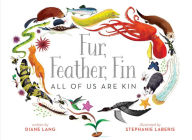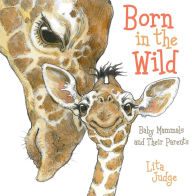Parents’ Choice Silver Honors Winner
From the award-winning author of Mama Built a Little Nest comes an oh-so-clever picture book that explores the feathers, fur, skin, or hair that different animals wear!
Some animals wear feathers.
Some animals wear hair.
Some animals wear prickly spines
and roam without a care!
At first glance, a wild animal’s appearance may seem simple. But there is fascinating science behind every part of an animal’s physique—from its nose to its toes! Celebrated author Jennifer Ward explores different kinds of fur, feathers, skin, and scales in this nonfiction picture book that’s truly like no other. From porcupines and polar bears to octopuses and owls, you’ll never see animal outerwear the same way again!
January 1, 2017 - Booklist
In spare, gentle rhyme, this vibrantly illustrated picture book introduces young readers to the very basics of animal form. “Some animals wear armor. / Some wear a traveling shell. / Some wear tough and pointy horns that serve them very well,” Ward writes as Tsong showcases an armadillo’s tough skin, a shelled tortoise and a hermit crab, and the horns of a rhino and antlers of a gazelle. Back matter includes a list of the animals in the order that they appear, with some details about each feature showcased in the text. The collage-style illustrations focus on particular aspects of each animal: a lion’s gaping yawn is front and center on one page, but it’s the mane (“Some animals wear wild hair”) that is its most defining feature. Back-to-back spreads on colorful animals—a camouflaging chameleon and octopus—are especially interesting. While not particularly science heavy, this is an eye-catching first look for budding scientists, and a final page on the only animal who “wears clothes from head to toes” will pique that interest even further. — Maggie Reagan
School Library Journal
02/01/2017
PreS-Gr 1—Beginning with patterned tail feathers on the title page that lead to a multicolored bird, digitally painted spreads feature a vibrant progression of animals with feathers, hair, spines, armor, shells, horns, skin, scales, or fur, plain or gaudy—and "only one wears clothes from head to toes." The book's art is brightly colorful, with detailed images that convey the motion of each animal from varied perspectives and highlighted words with a change of font. Additional information pages follow the introductory rhyming text, describing each animal with words for building vocabulary (bristle, contour, down, crustacean, mollusk, gills, pachyderm) or interesting facts, e.g., "the muscles of an octopus can create lumps, ridges and spikes…to match the texture of its surroundings." Each featured creature is also categorized as a mammal, an amphibian, a bird, a fish, or a reptile. VERDICT An eye-catching addition for younger readers, with multiple uses in classroom or library.—Mary Elam, Learning Media Services, Plano ISD, TX
Kirkus Reviews
2016-11-23
Sparse, rhyming text and lush collages impart elementary facts about different animals' body coverings. The colors, shapes, and textures of the artwork are a glorious complement to the simple, nicely scanning, just-barely-informational text. A set of speckled feathers stretching over the title pages is revealed to be the tail feathers of an awesome, pheasantlike bird spread over the next two pages. The text states, in bright, large letters against a green background, "Some animals wear feathers." A monkey leaps across the next pages, with the bold text: "Some animals wear hair." An aerial view of a porcupine's quills finishes the verse with "Some animals wear prickly spines / and roam without a care." The art invites gazing and revisiting—especially the four pages devoted to a chameleon of psychedelic coloration. The final verse and illustration of a giggling, brown-skinned child in the bathtub will delight most toddlers—who are still entranced by differences between humans and other animals—but limit the book's appeal to older readers. The endnotes name each animal in its order of appearance and supplement the primary text with scientific facts. However, the absence of a glossary leaves it up to adult readers to define such terms as "mammal," "reptile," "gills," "crustacean," "mollusk," and "amphibian." The artwork is spectacular, but its factual content is not so well-presented. (Informational picture book. 2-6)
Read More























